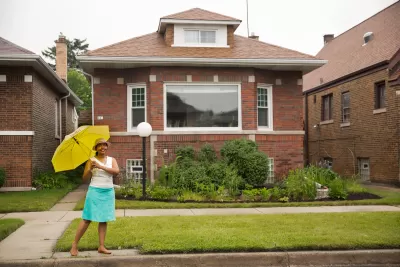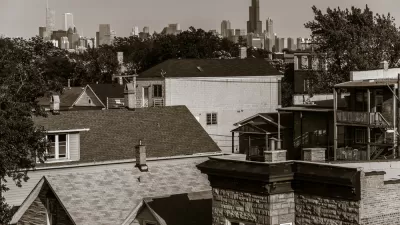Natalie Moore details her experience in Chicago's Chatham neighborhood as the child of black home owners in a segregated city.

"My parents, Joe and Yvonne Moore, married in 1974, and their first home decision was a cultural and practical choice: They wanted to live in an African-American community on Chicago’s South Side, put down roots and start a family," Natalie Moore writes for WBEZ, detailing her family's experiences as black homeowners. "Before 1948, Chatham had been all white and deliberately kept blacks out, an example of the discrimination that met migrants from the South," Moore writes. After the Supreme Court ruled that this discrimination was illegal, the neighborhood went from all white to all black. Moore describes seeing white people on the Red Line only when there was a White Sox game at Comisky Park several miles north of her home.
When she was in college, Moore's parents sold their home in Chatham, the timing turned out to work in their favor, because of the housing collapse. "Subprime loans were targeted at black homeowners, and those loans were concentrated in black neighborhoods, like Chatham," Moore reports. Moore faced a whole other battery of issues when she became a homeowner in Chicago's Bronzeville neighborhood. When Moore was looking to move to a larger home, she found it hard to sell her condo because the bank’s appraiser would not give her what seemed to be a fair valuation. Moore spoke with a realtor who said this is an issue homeowners face particularly in black neighborhoods. "Even though Chicago has seen a glut of condos, she said, “there are unique forces at play in black neighborhoods when it comes to homeownership, like fighting bad appraisals," Moore writes.
FULL STORY: Black Homeownership: The Promise and The Pitfalls

Planetizen Federal Action Tracker
A weekly monitor of how Trump’s orders and actions are impacting planners and planning in America.

Restaurant Patios Were a Pandemic Win — Why Were They so Hard to Keep?
Social distancing requirements and changes in travel patterns prompted cities to pilot new uses for street and sidewalk space. Then it got complicated.

Map: Where Senate Republicans Want to Sell Your Public Lands
For public land advocates, the Senate Republicans’ proposal to sell millions of acres of public land in the West is “the biggest fight of their careers.”

Maui's Vacation Rental Debate Turns Ugly
Verbal attacks, misinformation campaigns and fistfights plague a high-stakes debate to convert thousands of vacation rentals into long-term housing.

San Francisco Suspends Traffic Calming Amidst Record Deaths
Citing “a challenging fiscal landscape,” the city will cease the program on the heels of 42 traffic deaths, including 24 pedestrians.

California Homeless Arrests, Citations Spike After Ruling
An investigation reveals that anti-homeless actions increased up to 500% after Grants Pass v. Johnson — even in cities claiming no policy change.
Urban Design for Planners 1: Software Tools
This six-course series explores essential urban design concepts using open source software and equips planners with the tools they need to participate fully in the urban design process.
Planning for Universal Design
Learn the tools for implementing Universal Design in planning regulations.
Heyer Gruel & Associates PA
JM Goldson LLC
Custer County Colorado
City of Camden Redevelopment Agency
City of Astoria
Transportation Research & Education Center (TREC) at Portland State University
Camden Redevelopment Agency
City of Claremont
Municipality of Princeton (NJ)





























